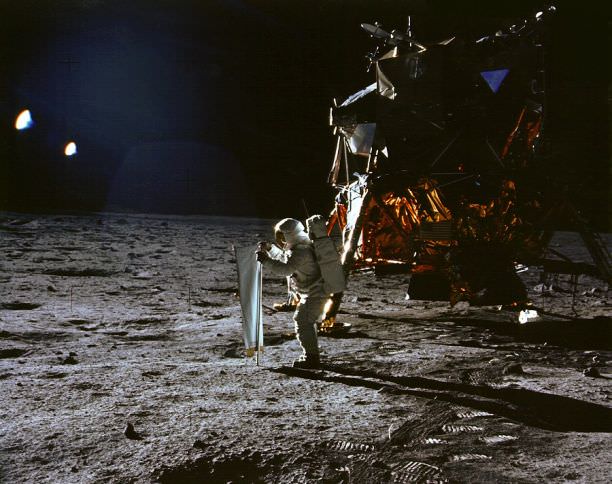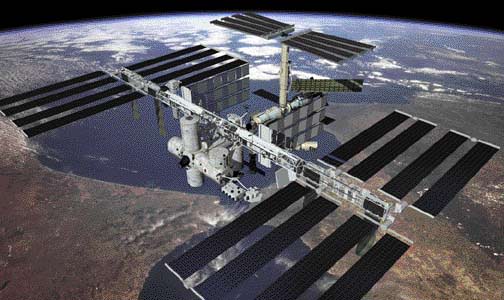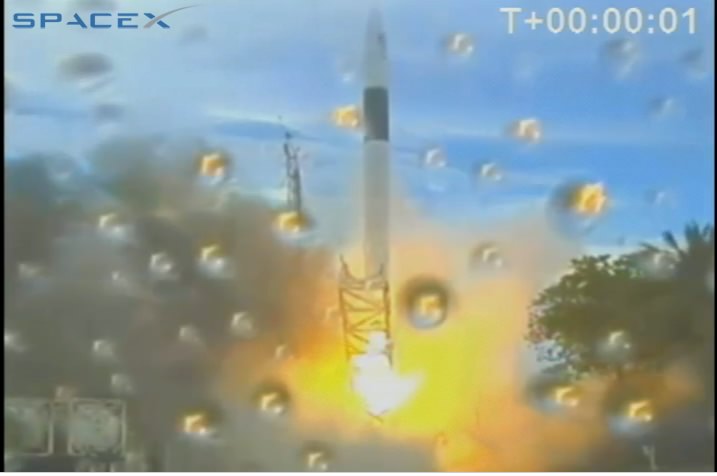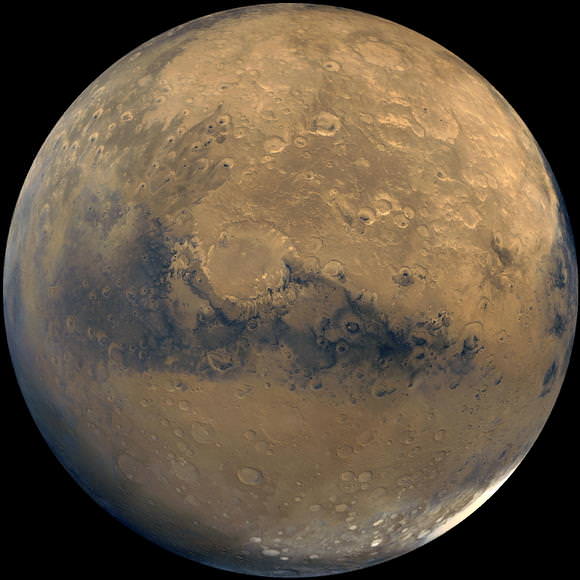Newscaster Walter Cronkite has passed away at the age of 92. He was admired and known for his enthusiastic coverage NASA’s space missions, from the early Mercury launches, through the ground-breaking Gemini missions, to the subsequent moon landings — which at times left him speechless — and the space shuttle program.
Continue reading ““That’s the Way It Is” — Apollo Supporter Walter Cronkite Dies”
Apollo 11 Anniversary Link-O-Rama
The Apollo 11 40th anniversary is coming at us fast and furious! With restored images and video, mission audio, interviews, and special features, who can keep track of it all? Well, we’re going to try. We’ll post here all the links we can find that has anything to do with the anniversary. If you find something of interest elsewhere you think we should add, email it to Nancy or post it in the comments, and we’ll add it. This will be Apollo 11 anniversary HQ!
Audio, Video, etc:
Listen to Apollo 11 mission audio “live” to the minute as it happened 40 years ago (July 16-24) or listen later at any time: We Choose the Moon
High-Definition Restored Apollo 11 Video from NASA
Read the transcriptions of the recorded audio
Find other recordings and transcriptions here.
Video from INA French television’s broadcasts from July 1969
IYA Malta’s Moon for All Mankind video
Cool websites:
NASA’s Apollo 11 40th Anniversary website
NASA’s Apollo Missions website
NASA’s Interactive Tranquility Base
NASA’s Apollo Lunar Surface Journals
Detailed Summaries of the Apollo missions
The Smithsonian National Air and Space Museum’s Apollo 11 site
The Boston Globe’s Big Picture does Apollo 11
Discovery News Apollo 11 Slideshow
Dramatic panoramas of the Apollo landing sites.
Miscellaneous:
NASA Laments Missing Apollo 11 Film, Makes Do With What’s Left
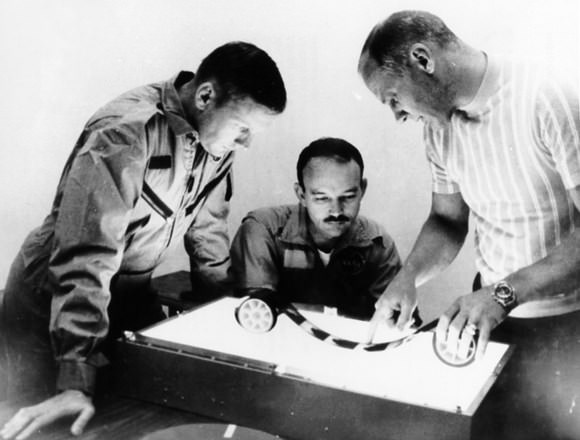
[/caption]
The engineers who helped beam images of the lunar surface to Earth in 1969 are doing a little hand-wringing these days – because original film of the historic event got recycled at NASA rather than preserved.
Still, the agency has teamed up with a Hollywood restoration team to collect and improve on backup copies of the Apollo 11 feat. The clearer, digitized versions will be available in a few months.
Dick Nafzger, a NASA engineer at Goddard Space Flight Center who oversaw television production of Apollo 11, said the initial tape was stored in the national archives until the Apollo program no longer needed the data it contained.
Sometime after that, NASA thinks, the tapes were pulled from their boxes, erased and used to record data for subsequent missions.
It wasn’t until years later that Nafzger and others understood the historical value of the tapes — and the gravity of their loss.
“When I was a 28-year-old engineer, maybe I didn’t understand that. But I certainly do now,” said Nafzger, who spoke at a NASA press conference on Thursday. He hastened to add that he wasn’t in the loop when the tapes were being erased; he and others discovered the tapes’ fate only later, when they became interested in improving the notoriously grainy footage.
Because backup tapes of the mission weren’t so readily discarded after the celebrated lunar landing on July 20, 1969, the engineer-turned-historian has been given another chance.
Nafzger was joined at the press conference by Stan Lebar, the now-retired Westinghouse electric program manager who spearheaded the lunar camera, and Mike Inchalik, president of Lowry Digital in Burbank, California. Together, the men have managed to secure tapes from Sydney, Australia and the archives at CBS, where the live footage was streamed from Houston on that monumental day.
They’re bringing the best of digital technology to bear on what was at the time the cutting edge of videography, even though it was made harder on the eyes of television audiences by conversion to broadcast form. For restoration purposes, the original footage that’s been recovered is actually quite useful, Inchalik said.
“Every frame in that sequence has some information that it shares with others … if you can extract what doesn’t belong, you can make those pictures clearer,” he said.
The team showed four short clips from the $230,000 restoration project at the press conference — including moments where both Neil Armstrong and Buzz Aldrin first set foot on the lunar surface. The “after” images are indeed clearer, with more accurate lightning and sharper contrast.
Inchalik said his company is sensitive to preserving the historical integrity of the footage, and aware that any missteps could fuel conspiracy theories that the lunar landing was faked.
“There are elements in the original where we’re not touching or making corrections we would normally make,” he said. “There’s some value in the fact that we’re not a special effects house; we’re a restoration house.”
Nafzger was careful to point out that no new footage will be issued of the landing; all the restored tape comes from video that has already been released. The final product is expected in September.
De-Orbit the ISS in 2016? Don’t Bet On It
[/caption]
There’s been a fair amount of outcry this week regarding a quote in the Washington Post from International Space Station program manager Michael Suffredini that the ISS would be decommissioned, de-orbited and destroyed in 2016. Suffredini made that statement to the Augustine Commission, the presidential panel reviewing NASA’s future plans, at a hearing in June. But please don’t think ditching the space station is a done deal. Fiscal year 2016 is currently when the existing agreements between the international partners – and the all-important funding – expire. Suffredini also told the panel that discussions with the partners indicate all involved would like to see station operations continue past FY2016. NASA spokesman Kelly Humphries told Universe Today that the heads of the participating space agencies recently reaffirmed their common interest in using the station “to its full capacity for a period that is meaningful for our stakeholders and its users.”
Additionally, Humphries said the international partners recently noted that as things stand now, a continuation of operations beyond 2015 wouldn’t be precluded by any significant technical challenges.
“NASA is working with the international partners to understand if there are any technical constraints to extending the life beyond 2016,” he said. “That’s the first step in confirming the belief that we don’t have any major technical concerns.”
The FY 2016 date was originally based on how long the station would be operational. That doesn’t take into account delays that have occurred in bringing various modules and hardware to orbit.
“Based on the projected design lifetime of the hardware that we have in orbit, the current International Space Station program baseline does have operations ending in fiscal year 2016, which is the end of calendar year 2015,” Humphries said. “However, there hasn’t been any policy decision made as to whether to continue or preclude any additional space station operations beyond 2016. And NASA hasn’t taken any action to preclude those operations.”
Humphries said that no one at NASA is going to speculate how long – or short – the station’s life might be. “NASA’s policy is not to make or allow any decision to be made that would cause the space station to be terminated on a particular date,” he said.
But as in all government sponsored space activities, funding is the biggest question mark. “The continued funding of the station is a decision that will be made by the leadership in the nations that are participating as partners in the endeavor,” Humphries said. However, he added, the heads of agencies did commit to work with their respective governments to assess whether or not they can support the station after 2015.
Suffredini simply laid out the course of action that would occur if agreements with the partnering nations were allowed to expire, which seems unlikely. As far as the funding, those details are up to the governments — and the taxpayers — of the participating nations. So if you have an opinion — one way or the other — make your voice be heard.
But what does Suffredini really think? As he told the Augustine Commission, “My opinion is it would be a travesty to de-orbit this thing.”
Sources: Washington Post, phone interview with Kelly Humphries
Could Ares Be Axed?
[/caption]
Members of the Augustine Panel reviewing NASA’s future plans have asked the space agency to consider different approaches to send astronauts back to the moon. According to an article in the Orlando Sentinel, panel members have told NASA they want to see the effects of both “minor tweaks and wholesale changes to its Constellation Program,” which includes the newly designed Ares rocket and the Orion crew capsule. Ares has been controversial from the start, but NASA has spent the past four years and more than $3 billion creating and defending the rocket. Would starting over just mean a bigger gap between the shuttle and whatever comes next?
Current plans have the Ares rocket ready to launch by 2015, however, most critics say there’s no way the Constellation program can meet its 2015 launch schedule — let alone return astronauts to the moon by 2020 — given the technical problems and multibillion-dollar cost overruns on its Ares I rocket.
The White House named the 10-member review panel, chaired by retired Lockheed Martin CEO Norm Augustine, to review NASA’s manned-space strategy for the next decade. The Sentinel reported, “One of the [panel’s] subcommittees has asked the [Constellation] program to present both the baseline … program and one of the variants that they have studied as well,” said one committee official, who asked not to be named because he’s not authorized to speak for the committee.
The official provided no details about the “variant,” but the request coincides with NASA pulling engineers at the Marshall Space Flight Center in Huntsville Alabama from their work on Ares I to study creation of a smaller version of the Ares V that could carry both crew and heavy equipment.
Other possible options include a shuttle-derived architecture presented to the committee by shuttle program manager John Shannon, or the Direct 3.0 launch system created by a group of NASA engineers.
The Sentinel reports that NASA insiders and contractors say pulling engineers from Ares is “far from standard practice and could herald the demise of the Ares I.”
“They are looking at a whole new launch architecture,” the Sentinel quoted one NASA contractor familiar with the study. “Although it’s still too early to pronounce Ares I dead, it is safe to assume that members of the committees have doubts about it.”
Meanwhile, NASA presses ahead with a planned first launch test of the Ares I-X rocket planned for August 30. Just today the third motor segment for rocket has been moved to the Vehicle Assembly Building for to mate with the rest of the Ares stack tonight.
Stay tuned.
Source: Orlando Sentinel
A Tale of Two Launches
[/caption]
While space shuttle Endeavour’s launch on Monday was scrubbed –again — due to weather, another launch took place later, which successfully launched the first commercial payload on board a rocket built by a commercial space company. SpaceX launched their Falcon 1 rocket from Omelek Island at Kwajalein Atoll to put a Malaysian RazakSAT satellite in a near equatorial orbit. SpaceX was able to overcome troubles with a helium system as well as bad weather, both of which caused delays. But eventually, the Falcon 1 launched flawlessly.
This was the second successful launch in five tries for the Falcon 1 rocket. Later this year. SpaceX hopes to launch its larger Falcon 9 rocket from Cape Canaveral
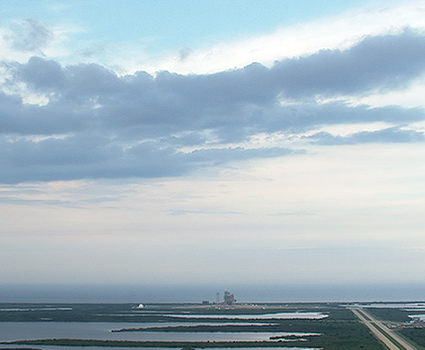
Meanwhile, for the second day in a row, thunderstorms near the Kennedy Space Center forced a scrub for Endeavour and her crew. It was the fifth delay for the STS-127 mission, going back to a hydrogen leak which delayed the launch in June.
NASA has decided to pass up a Tuesday launch opportunity, and try for a sixth launch attempt Wednesday July 15 at 6:03:10 p.m. EDT. The weather looks like it has a better chance of allowing a launch (60 percent chance of good weather as opposed to a 40 percent chance on Tuesday), plus the extra day will give .
engineers a chance to repair a rocket thruster rain cover came loose.
Delaying the shuttle launch may mean rescheduling when a Progress resupply ship can dock to the space station. If it launches as scheduled on July 24, it needs to dock by July 29.
Going to Mars Together
[/caption]
From the “this makes complete sense” department: NASA and ESA have established an initiative to make future explorations of Mars a joint venture. The ESA Director of Science and Robotic Exploration, David Southwood, met with NASA’s Associate Administrator for Science, Ed Weiler at the end of June and created the Mars Exploration Joint Initiative (MEJI) that will provide a framework for the two agencies to define and implement their scientific, programmatic and technological goals at Mars. The initiative includes launch opportunities in 2016, 2018 and 2020, with landers and orbiters conducting astrobiological, geological, geophysical and other high-priority investigations, leading up to a sample return mission in the 2020s.
Both NASA and ESA have been reassessing their Mars exploration programs, and Weiller revealed at a press conference last year (when it was announced that the Mars Science Laboratory would be delayed) that NASA and ESA would seek to work together. But now it is official.
The two space agencies will be working together to plan future missions. A joint architecture review team will be established to assist the agencies in planning the mission portfolios. As plans develop, they will be reviewed by ESA member states for approval and by the US National Academy of Sciences.
Source: ESA
Faster, Cheaper (and Better?) Way to the Moon
The word this morning from several NASA Twitterers is that the stacking of the new Ares I-X rocket for its upcoming test flight is temporarily on hold. Everyone is waiting for word from a NASA executive session reconsidering the plan. And perhaps it might have something to do with an alternative plan to return to the Moon, submitted by shuttle program manager John Shannon to the Augustine Commission, the independent panel that is reviewing NASA’s current vision, including the Constellation program. Interestingly, Shannon says he was strongly encouraged by a top NASA administrator to present his idea to the panel. Shannon’s option would be faster – perhaps eliminating at least a year of the projected 5-year gap between the shuttle and Constellation. It would be cheaper: $6.6 billion vs. $35 billion for Constellation. But would it be better? Take a look at this video that Shannon presented to the Augustine Commission.
Continue reading “Faster, Cheaper (and Better?) Way to the Moon”
NASA, Japan Release Most Complete Topographic Map of Earth
[/caption]
Topographic maps are some of the most used and valuable maps for both government and the general public. Now, NASA and Japan have released a new digital topographic map of Earth Monday that covers more of our planet than ever before and was created from nearly 1.3 million individual stereo-pair images collected by the Japanese Advanced Spaceborne Thermal Emission and Reflection Radiometer, or ASTER, on board NASA’s Terra spacecraft. It is available online to users everywhere at no cost.
“This is the most complete, consistent global digital elevation data yet made available to the world,” said Woody Turner, ASTER program scientist at NASA Headquarters in Washington. “This unique global set of data will serve users and researchers from a wide array of disciplines that need elevation and terrain information.”
ASTER is one of five Earth-observing instruments launched on Terra in December 1999. ASTER acquires images from the visible to the thermal infrared wavelength region, with spatial resolutions ranging from about 50 to 300 feet.
According to Mike Abrams, ASTER science team leader at JPL the new topographic information will be of value throughout the Earth sciences and has many practical applications. “ASTER’s accurate topographic data will be used for engineering, energy exploration, conserving natural resources, environmental management, public works design, firefighting, recreation, geology and city planning, to name just a few areas,” Abrams said.
Click here for visualizations of the new ASTER topographic data.
Click here to download the ASTER global digital elevation model.
NASA and Japan’s Ministry of Economy, Trade and Industry, known as METI, developed the data set.

Previously, the most complete topographic set of data publicly available was from NASA’s Shuttle Radar Topography Mission. That mission mapped 80 percent of Earth’s landmass, between 60 degrees north latitude and 57 degrees south. The new ASTER data expands coverage to 99 percent, from 83 degrees north latitude and 83 degrees south. Each elevation measurement point in the new data is 98 feet apart.
The ASTER data fill in many of the voids in the shuttle mission’s data, such as in very steep terrains and in some deserts,” said Michael Kobrick, Shuttle Radar Topography Mission project scientist at the Jet Propulsion Laboratory. “NASA is working to combine the ASTER data with that of the Shuttle Radar Topography Mission and other sources to produce an even better global topographic map.”
Source: NASA
Expedition 21 Star Trek Poster
[/caption]
Is NASA becoming creative, fun and hip in their old (50 plus) age? They are Tweeting and Facebook-ing like crazy, and also getting quite adept at imaginative promotional images. A new poster for the next Expedition crew for the International Space Station is now available and it has a Star Trek theme. This is a great way for NASA to capitalize on the renewed popularity of Star Trek, while bringing the names of faces of the ISS crews to the public in an enjoyable and entertaining way. This Expedition 21 poster is available in downloadable versions in medium and large files (pdf).
See NASA’s entire collection of mission posters here at NASA’s Spaceflight Awareness page.
Check out all the ways NASA is connecting with people online here.
Hat tip to NASA Watch!

